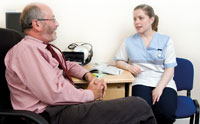Risk alert: Clinical protocols
Post date: 04/02/2014 | Time to read article: 6 minsThe information within this article was correct at the time of publishing. Last updated 18/05/2020
 Diane Baylis, MPS Clinical Risk Manager, discusses how protocols enable practice teams to practise the right way.
Diane Baylis, MPS Clinical Risk Manager, discusses how protocols enable practice teams to practise the right way.
Clinical protocols represent the framework for the management of a specific disorder or clinical situation and define areas of responsibility. They reduce variation, maintain the quality of patient care and are documentary evidence of the standard of care to be provided.
Producing clinical protocols is a useful educational exercise that allows the team to review their current practice in light of national guidelines. In MPS’s experience many practice nurses, although adhering to national guidance, do not have locallyproduced clinical protocols.
MPS performs Clinical Risk Assessments on thousands of practices every year.1 During CRSA visits in 2013 MPS found that 78.4% of the practices visited had issues relating to protocols. The issues were:
- More than 46.4% had no/poor/ unsigned clinical protocols
- More than 41.8% had issues relating to archiving.
You should ensure that your local practice protocols address the following:
- Knowledge and skills framework to assess clinical competency
- Consent
- Risk assessment of procedures and environment
- Documentation and record keeping
- Evidence/research based in line with national guidance
- Reflect local services
- Identify who carries out key parts of the care
- The use of Patient Group Directions, and Patient Specific Directions where appropriate.
"Clinical protocols represent the framework for the management of a specific disorder or clinical situation and define areas of responsibility"
Disease management protocols usually also:
- Define the circumstances where patients are referred on from nurserun clinics to either a GP or directly to secondary care
- Describe the practice’s criteria for stepped increases in therapy.
There is a danger that protocols can be developed by one individual in isolation, resulting in a lack of ownership by other members of the practice team. This can result in protocols that are rarely adhered to, and are only occasionally updated. This will detract from their usefulness and result in members of the practice team working in different ways, with variable standards. Protocols should:
- Be discussed and agreed by the relevant members of the team
- Be developed with contributions from representatives from different parts of the practice
- Be revised regularly and amendments made if necessary
- Be easily accessible.
Protocols should be clearly marked with dates of creation, ratification and future review, the version number of the policy and they should be reviewed annually. Outdated protocols should be retained for at least eight years, in case of litigation. Failure to retain copies of historic policy documents can make it difficult for organisations to successfully defend claims. Claims can date back many years and it is essential that the practice is judged against the expectations and knowledge at the time.
Patient Group Directions (PGDs)
 PGDs are written agreements for the supply and administration of medicines by registered nurses (who are not prescribers) to a group of patients who may not be individually known before they present for treatment.
PGDs are written agreements for the supply and administration of medicines by registered nurses (who are not prescribers) to a group of patients who may not be individually known before they present for treatment.
Since August 2000, PGDs are a statutory instrument and are legally binding and they should be individually negotiated between the nurse and employer. PGDs must be signed by a doctor and pharmacist and must meet specific criteria.2
Since April 2013, the responsibility for the authorisation of PGDs now lies with the CCGs. NICE have recently published guidance regarding PGDs.3
Examples of common patient groups in general practice are:
- Infants and children requiring immunisation
- Those requiring immunisation for foreign travel
- Those requiring medication for common acute or chronic illness.
Patient Specific Directions (PSD)
The changing role of nurses has led to more work being allocated to healthcare assistants. MPS has found that healthcare assistants increasingly undertake the administration of flu and B12 injections. If a healthcare assistant is required to administer medications this must be done using a PSD.
The NMC state that a PSD “is a written instruction from a qualified and registered prescriber for a medicine including the dose, route and frequency or appliance to be supplied or administered to a named patient.”4
"If a healthcare assistant is required to administer medications this must be done using a PSD"
The PSD must include:
- Name of patient and/or other individual patient identifiers
- Name, form and strength of medicine (generic or brand name where appropriate)
- Route of administration
- Dose
- Frequency
- Start and finish dates
- Signature of prescriber.
The employer, which in general practice is typically the GP partners, is responsible for ensuring that staff are properly trained and undertake only those responsibilities specified in their job descriptions. If non-regulated staff are to administer medicines using a PSD, those delegating the duty must ensure that the healthcare assistants are trained and competent to do so safely. PSDs must be supported by a practice protocol.
Training
The employer, which in general practice is typically the GP partners, is responsible for ensuring that staff are properly trained and undertake only those responsibilities specified in their job descriptions
MPS has found that many practices are struggling to source training for their staff. In many areas the transition from PCT to CCG is still in progress and practices have found that training that was previously provided by the PCT is not provided by the CCG. Of the practices that we visited to undertake a CRSA, 88.9% of those practices had issues with training or training needs outstanding.
"The employer, which in general practice is typically the GP partners, is responsible for ensuring that staff are properly trained and undertake only those responsibilities specified in their job descriptions"
Nurses must maintain their registration by meeting the post registration and practice (PREP) standards set by the NMC.5 However, the NMC is in the process of reviewing and updating the standards for the maintenance and renewal of registration. This will form the basis of their approach to revalidation which will be launched later in 2014. A portfolio of training is recommended to help nurses keep up to date, and employers have a duty to support staff to meet their training needs.
Training should include:
- Annual mandatory updates training such as CPR, safeguarding, health and safety, fire safety and infection control
- Reflective practice
- Individual learning needs identified at appraisal
- Personal development plan.
Nurse indemnity
From October 2013 indemnity became a mandatory requirement for all nurses registered with the NMC.6 Many nurses working in NHS trusts will be covered by their employer, however for nurses working in general practice this is not always the case. Practice nurses and nurse practitioners have an obligation to ensure that adequate indemnity arrangements are in place.
Summary
In the high-pressured busy environment that is general practice, it is imperative that all members of the practice team adhere to protocols and are trained sufficiently in their role to enable them to continue to practise safely.
References
- Clinical Risk Self Assessments for GP Practices
- Royal College of Nursing. Patient Group Directions: guidance and information for nurses (2004)
- Nursing and Midwifery (2010) Standards for medicines management
- National Institute for Clinical excellence, Good practice guidance for PGD’s. August 2013
- Nursing and Midwifery Council: PREP standards
- Nursing and Midwifery Council: Professional indemnity.
Case study
One busy Monday morning Mary saw Emily, a 21-year-old female who presented with a history of vague lower abdominal pain, loose motions and malaise. Mary made a diagnosis of gastroenteritis and advised Emily to take analgesia, fluids and sent off a stool sample. In the early hours of Tuesday morning Emily developed severe abdominal pain and collapsed. An ambulance was called, but despite the best efforts of the paramedics Emily was pronounced dead upon arrival at the emergency department. A postmortem examination confirmed the cause of death as haemorrhage from a ruptured right tubal pregnancy. Unfortunately the protocol that Mary was following did not mandate the following:
Naturally, Mary was devastated at the tragic outcome of this case and her professional confidence was shaken to the extent that she needed to have several weeks off work. However, the medicolegal sequelae of the incident were not resolved for a further two years. Mary was in a category of MPS membership that entitled her to request assistance in relation to these matters. Inquest Emily’s death was reported to the coroner and they instigated a police investigation into the circumstances surrounding Emily’s death. Mary underwent the harrowing experience of being interviewed under caution by the police, supported by an MPS instructed solicitor. The police did not pursue any criminal charges in this matter, but Mary was called to give evidence at the coroner’s inquest. The coroner returned a verdict of natural causes, but wrote to the practice asking that they review and amend their managing minor illness protocol. NMC action The family made a complaint about Mary to the NMC. The council did not take any action against Mary on the basis that she followed the (albeit flawed) protocol. Civil claim The family pursued a claim in negligence against the practice. Given the concerns about the protocols, the claim was settled on behalf of the practice by MPS. |
 Mary had been a practice nurse for four years at Green Surgery. After a discussion with the senior partner, Dr D, it was decided that she would undertake a course in the management of minor illnesses. Mary completed the course and started to undertake her own minor illness clinics, working in accordance with protocols adopted from a neighbouring practice and nominally under the supervision of Dr D.
Mary had been a practice nurse for four years at Green Surgery. After a discussion with the senior partner, Dr D, it was decided that she would undertake a course in the management of minor illnesses. Mary completed the course and started to undertake her own minor illness clinics, working in accordance with protocols adopted from a neighbouring practice and nominally under the supervision of Dr D.

